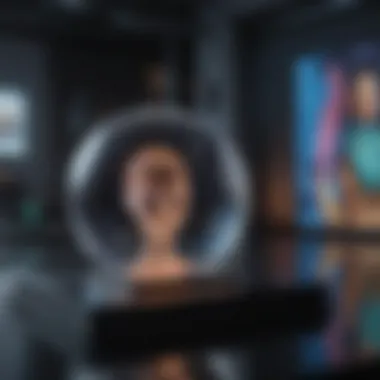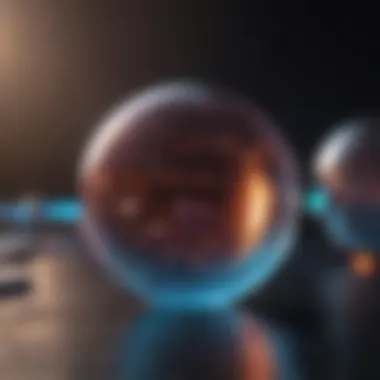Hologram Screen Material: An In-Depth Exploration


Research Overview
Summary of Key Findings
The exploration of hologram screen materials reveals that they are fundamentally designed to manipulate light in intricate ways to create three-dimensional images. Recent advancements in polymers and photonics have significantly improved the clarity and stability of holograms. Moreover, applications span various fields, including augmented reality, efficient display systems, and educational tools. Understanding these materials requires a grasp of their unique properties and the scientific principles behind them.
Background and Context
Holography dates back to the 1940s, but its application in screen materials is relatively recent. Innovations in optics and materials science have enabled the creation of holographic displays that go beyond conventional screens. As industries demand more immersive experiences, the development of hologram materials has become increasingly important. This surge is driven by the need for better visual communication, data visualization, and entertainment experiences among audiences.
Methodology
Experimental Design
Hologram screen material studies often rely on a combination of theoretical and empirical approaches. Researchers develop prototypes using various materials, including photopolymers and optical films. Experiments are conducted to test light diffraction efficiency, color fidelity, and durability under different environmental conditions.
Data Collection Techniques
Data is typically collected via precision instruments that measure light interaction with the materials. Techniques may include interferometry and spectrophotometry. These methods offer insights into how holographic materials can be optimized for various applications.
"Modern hologram technologies may reshape how we interact with digital information, expanding our understanding of display systems and visual communication."
Intro to Hologram Technology
Holography represents a significant advancement in the realm of imaging technologies. It creates three-dimensional images through the interference patterns of light, resulting in visuals that can be perceived as lifelike. Understanding the foundations of holography is crucial as it opens the door to numerous applications ranging from medical imaging to entertainment systems.
This section explores not only the definition and the historical context of holography, but also its implications in contemporary technology. Holography depends on specific scientific principles that dictate how light interacts with materials. The benefits of incorporating holographic technology are manifold. They include enhanced imaging quality, increased depth perception, and potential interactive capabilities in displays.
In an increasingly digital world, the importance of holography underscores its relevance across industries. Researchers and professionals must grasp these dynamic developments to leverage holography effectively. Thus, understanding holography is not merely academic; it's essential for future technology progress.
Definition of Holography
Holography is defined as the photographic representation of light fields, capturing a three-dimensional image of an object. Unlike traditional photography, which captures a flat image, holography involves the capturing of light scattered from the object and reconstructing that light to give a 3D appearance.
When a laser beam illuminates an object, it creates a unique interference pattern on a photographic medium. This recorded pattern can reproduce spatial information when illuminated by a laser again. The ability to represent an object in three dimensions allows observers to view the image from different angles, enhancing the sense of realism.
Historical Context
The inception of holography can be traced back to the early 20th century. It was Dennis Gabor, a Hungarian scientist, who proposed the holography concept in 1947. Gabor's work aimed to improve electron microscopy; however, it wasn’t until lasers became widely available in the 1960s that practical applications of holography emerged.
The initial applications of holography were predominantly in scientific sectors, such as optics and microscopy. Over the decades, the technology has evolved, finding a place in consumer products, security features, and artistic displays. Recent technological advancements have significantly expanded the accessibility and versatility of holograms.
"Holography has the potential to revolutionize many fields by providing a new method for visual communication and data representation."
This historical overview of holography illustrates its transformative journey from scientific curiosity to a prominent player in modern technology.
Understanding Hologram Screen Materials
Hologram screen materials play a crucial role in the development and application of holographic technologies. The effectiveness of holographic displays relies heavily on the specific materials used to create the images. Understanding these materials allows us to appreciate their benefits and limitations, aiding in the innovation of better functionalities. In a field constantly evolving, knowledge about the composition and types of materials informs researchers and manufacturers about the capabilities and potential improvements on the horizon.
Composition of Hologram Materials
The composition of hologram materials is at the core of their functionality. Holographic materials are designed to interact with light in unique ways, allowing for the creation of three-dimensional images. The right composition can enhance the clarity, durability, and responsiveness of the holograms produced. Materials usually contain sensitive photoactive components, enabling them to record and reproduce light patterns.
Types of Holographic Materials
Several types of holographic materials are used in the creation of holograms. Each type has distinct characteristics that contribute to its applications and effectiveness. Understanding these different materials allows for an appreciation of their unique benefits and applications.
Photo-polymers


Photo-polymers are one of the most significant types of holographic materials. Their main characteristic is their sensitivity to light, which allows them to record high-resolution holograms effectively. This sensitivity is advantageous for recording precise data and enables more efficient readout processes. Photo-polymers can be easily manipulated with light exposure, which enhances their versatility in various holographic applications. However, their sensitivity also imposes a limitation; they can degrade over time if exposed to excessive light, thus impacting longevity.
Photo-thermoplastics
Photo-thermoplastics are another vital type of holographic material. These materials can be processed using heat to achieve the desired holographic effect. Their primary characteristic is flexibility, which allows for easy shaping and application in diverse projects. This flexibility makes photo-thermoplastics a favored choice in packaging and security applications. However, they require specific temperature controls during processing, which can complicate production. Their ability to be molded into intricate designs does present significant advantages in certain scenarios.
Liquid Crystal Displays
Liquid crystal displays (LCDs) represent a different approach to holography. While they are generally known for two-dimensional displays, advancements have allowed them to be used in holographic applications. Their core characteristic includes the manipulation of liquid crystals to modulate light, enabling dynamic images. LCDs are popular for their efficient energy use and relatively low production costs. Despite their advantages, they can lack the full three-dimensional effect typical of other holographic materials. However, their continued refinement suggests future potential for genuine holographic representations.
"Understanding the nuances of holographic materials is vital for technological progression in this field."
Principles of Holography
The principles of holography are fundamental to understanding how holographic screens and their materials operate. Holography itself is a photographic technique that records the light scattered from an object and presents it in a way that appears three-dimensional. This process relies heavily on the concepts of interference and diffraction, which play crucial roles in creating and reconstructing holograms. Without grasping these principles, one cannot fully appreciate the complexities and innovations within holographic technology.
Moreover, an understanding of these principles sheds light on the benefits of holography in various fields. For instance, in medical imaging, the ability to visualize 3D images can enhance diagnostic accuracy. Additionally, in display technology, the principles underpinning holography allow for more immersive experiences. Thus, the principles of holography are not just theoretical concepts. They form the basis of practical applications that influence today's technological landscape.
Interference and Diffraction
Interference is a phenomenon that occurs when two or more light waves overlap, leading to a pattern of dark and light bands known as interference fringes. This effect is pivotal in creating a hologram. When a laser beam is split, typically using a beam splitter, one part illuminates the object while the other serves as a reference beam. The light reflected from the object and the reference beam then interfere with each other at a photographic plate or digital sensor, generating the interference pattern needed to form a hologram. This pattern encodes information about both the amplitude and phase of the light waves, which are crucial for reconstructing a three-dimensional image.
Diffraction complements the process of interference. It refers to the bending of light waves around obstacles and the spreading of light waves as they pass through a narrow opening. When the interference pattern is illuminated, light diffracts according to the pattern recorded. This diffraction allows the previously captured light to reconstruct the original object when viewed from different angles, creating the illusion of depth.
In summary, both interference and diffraction are essential to the effectiveness of holography. They are the mechanisms that enable the recording and reconstruction of holograms, making them key to the development of holographic technologies.
Recording Holograms
The process of recording holograms is a precise and technical endeavor. It begins with the illumination of the object by a coherent light source, usually a laser. The light interacts with the object, and the scattered light then reaches a photographic plate or a digital medium.
To successfully capture the holographic image, several factors must be carefully controlled:
- Light Source: The use of coherent light, such as that emitted from a laser, is crucial. Lasers provide both the necessary intensity and uniformity for effective holography.
- Environment: The recording must take place in a vibration-free environment to prevent distortion in the interference pattern.
- Recording Medium: The material used, such as a photo-sensitive film or digital sensor, must appropriately convert the incoming light into a permanent record.
Once the object is illuminated and the reference beam properly set, the light patterns are recorded. This intricate combination of light pathways is responsible for creating a holographic image that captures depth and dimensionality. After recording, the hologram can be processed and developed, leading to the final product, which can be viewed under the correct lighting conditions to yield a three-dimensional image.
Recording holograms is not just about capturing an image. It involves understanding complex interactions between light and materials, making it both an art and a science. The successful execution of this process results in the vivid and realistic representations offered by holographic displays.
Manufacturing Process of Holographic Materials
The manufacturing process of holographic materials is essential to the development of functional and high-quality holograms. This section highlights the significance of the various methodologies and standards in producing holograms suitable for diverse applications. Understanding these processes provides crucial insights into how holographic technologies can meet rigorous performance demands and achieve cost-effective solutions.
Synthesis Techniques
Synthesis techniques play a vital role in the creation of holographic materials. These methods determine the structural and optical properties of the final product. A few noteworthy techniques include:
- Polymerization: This process involves the use of photopolymers that change their properties when exposed to light. By manipulating the polymerization reaction, manufacturers can create materials that exhibit specific holographic characteristics.
- Coating: A thin film of a holographic material can be applied onto a substrate. This technique is useful in creating flexible holograms and can enhance the functionality of display systems.
- Casting: In this method, the holographic material is poured into molds. Once cured, this creates a solid structure that retains the holographic data. It is frequently used in creating durable holographic storage media.
Choosing the right synthesis technique depends on the intended application and the desired characteristics of the hologram. It is crucial for manufacturers to consider factors like cost, scalability, and performance.
Quality Control Measures
Quality control measures are critical in ensuring that holographic materials meet industry standards. Each stage of manufacturing requires careful monitoring to eliminate defects and optimize performance. Some important quality control strategies include:
- Optical Testing: It involves analyzing the interference patterns and diffraction efficiency of the holograms. Accurate measurements ensure that the holograms produce the expected visual output.
- Material Consistency: Monitoring the chemical composition and batch uniformity is essential. Variations in material properties can lead to inconsistent performance in holographic applications.
- Environmental Testing: Holographic materials must withstand various environmental conditions, such as temperature fluctuations and humidity. Testing ensures longevity and reliability in real-world applications.
By implementing rigorous quality control measures, manufacturers can guarantee that their holographic materials perform optimally under diverse conditions and applications.
The manufacturing process of holographic materials is multidimensional and requires a comprehensive understanding of various methods and quality standards. As technologies advance, the processes might evolve, leading to improved performance and new applications in holography.


Technological Advancements in Holographic Displays
The field of holography has seen significant advancements recently, especially in the context of displays. These advancements are crucial for both theoretical exploration and practical applications. A thorough understanding of the technological improvements will put into perspective the transformative potential of holographic displays in various domains like entertainment, education, and medical imaging. Such advancements enhance visual experiences, facilitate interactive experiences, and broaden the variety of application scenarios.
3D Holographic Displays
3D holographic displays represent a leap toward more immersive visual solutions. Unlike traditional displays, which rely on two-dimensional images, these systems project three-dimensional images that can be viewed from multiple angles without specialized eyewear. This capability opens up a new realm of possibilities in fields ranging from education to marketing. For instance, in medical imaging, 3D holograms can revolutionize how surgeons visualize anatomy during procedures, leading to improved outcomes.
Some notable features of 3D holographic displays include:
- Realistic Depth Perception: Viewers can perceive depth in ways that traditional screens cannot replicate.
- Wide Viewing Angles: These displays can be observed from various angles without losing clarity or detail.
- Enhanced Interaction: Holograms can be manipulated in real-time, making them ideal for interactive applications.
The development of such displays heavily relies on advances in materials science, digital processing, and optical engineering. Companies like Microsoft with their HoloLens technology continue to push this frontier further, increasing potential adoption in both consumer and professional sectors.
Interactive Holograms
Interactive holograms take the technology a step further by engaging users in real-time. This interaction creates a more dynamic experience where users can influence the displayed information through gestures or touch. Such features are not only useful in entertainment but also in educational settings, where users can explore complex concepts by interacting with them.
Key aspects of interactive holograms include:
- User Engagement: They offer a more engaging experience than conventional media by allowing for direct interaction.
- Practical Applications in Training: Industries such as aviation and medicine can utilize interactive holograms for simulations that facilitate hands-on learning.
- Customized Experiences: Users can tailor their interactions according to personal preferences.
In summary, the advancements in both 3D holographic displays and interactive holograms signify an essential evolution in technology. This evolution affects various fields, contributing immensely toward interactive experiences. Overall, these innovations enhance the future of visual communications and create opportunities for deeper understanding and interaction.
Applications of Hologram Screen Materials
Hologram screen materials are increasingly important in various industries due to their unique capabilities. This section delves into how these materials impact different fields, emphasizing their relevance and functionality.
Medical Imaging and Diagnostics
In the medical field, the application of hologram screen materials has transformed imaging techniques. Holography provides three-dimensional visualizations of internal organs and tissues, offering significant advantages over traditional imaging methods. This capability enhances diagnostic accuracy and allows for more effective treatment planning.
Holographic images can integrate with various imaging modalities, such as MRI and CT scans, creating a comprehensive view of a patient's condition. This integration not only improves visualization but also helps in educating patients about their health, not to mention aiding doctors in surgical planning.
Some key aspects of holography in medical imaging include:
- Increased Detail: Holograms can reveal structures in greater detail.
- Real-time Visualization: Surgeons can view 3D holographic images during operations for enhanced precision.
- Non-invasive Techniques: These methods reduce the need for invasive diagnostic procedures.
"With holography, the future of medical diagnostics looks significantly more promising, overcoming some technical limitations of conventional imaging."
Data Storage Solutions
Data storage is another realm where hologram screen materials demonstrate immense potential. Holographic data storage systems can pack information at densities far exceeding those of traditional storage devices. This means that more data can be stored in smaller physical spaces, making them highly efficient.
The principle behind holographic storage relies on the interference patterns produced by laser light. Data is encoded as holograms, which can be read from a single point, allowing for faster access times. Some significant benefits include:
- High Capacity: Vast amounts of data can be stored in a compact form.
- Speed: Holographic data retrieval is quicker compared to standard methods.
- Durability: Holographic materials tend to be more resilient to physical degradation, ensuring data longevity.
These ongoing developments in data storage highlight how materials science is innovating to meet modern demands.
Security Features
Security applications of hologram screen materials are becoming increasingly crucial in combating forgery and counterfeiting. Holograms can serve as unique identifiers, providing layers of authentication that are difficult to replicate. This not only helps in verifying the authenticity of documents or products but also adds a visual element that is often aesthetically pleasing.
Consider the following points regarding holographic security features:
- Tamper-proof: Holographic elements are hard to imitate, increasing security.
- Visual Distinction: The ability to create dynamic holographic images that change with viewing angle provides a recognizable feature.
- Diverse Applications: From banknotes to identification cards, the usage of holograms spans various industries.
With the rise in fraud cases, holographic security features represent a novel solution that offers both protection and innovation.


In summary, the applications of hologram screen materials extend deeply into sectors like healthcare, data storage, and security. They provide enhanced capabilities while addressing emerging needs. Their impact reflects both technological advancements and the ongoing pursuit of more efficient solutions.
Challenges in Holographic Technology
Holographic technology, while promising, faces several challenges that hinder its widespread implementation and development. Understanding these challenges is crucial for professionals and enthusiasts who seek to advance this field. These challenges revolve around material limitations and the need for cost efficiency.
Material Limitations
The materials used in holography pose significant constraints. Holographic recordings require high sensitivity and precision, but not all materials display these characteristics uniformly. For instance, photo-polymers are widely utilized due to their capacity to store three-dimensional images. However, these materials can degrade over time due to environmental factors such as light and temperature. This degradation affects the stability and longevity of holographic recordings, limiting their practical applications.
Selecting and optimizing materials for specific applications is vital. Recent research has focused on developing new photo-responsive materials that show improved durability and performance. Yet, the challenge remains to find a balance between performance and compatibility with existing technologies.
Moreover, the manufacturing processes involved can introduce imperfections. The alignment and exposure during the recording of holograms must be extremely precise. Even slight errors can lead to significant quality reduction. The ongoing quest for superior materials and techniques will play a key role in overcoming these limitations.
Cost Efficiency
Cost efficiency is another primary concern in the adoption of holographic technology. Developing and manufacturing high-quality holographic displays often involves complex and costly processes. Many institutions and companies face difficulty in justifying the investment needed for holographic systems compared to traditional display technologies.
Additionally, the production of holographic materials, such as specialized polymers or crystals, can be expensive. This cost factor is exacerbated when considering the low economies of scale. For instance, the production of photo-thermoplastics for holography might not yet be viable for mass-market applications.
Efforts are underway to streamline production processes and reduce costs. Encouragingly, advances in digital holography and the development of more affordable alternatives could play a substantial role in this regard. Addressing these cost-related issues will be fundamental for enhancing the accessibility and usage of holographic systems across different sectors.
"Understanding and addressing the material limitations and cost concerns is essential for the future of holographic technology."
Tackling these challenges will require coordinated efforts from researchers, industries, and academic institutions. Only through a comprehensive approach can the promise of holograms be fully realized.
Future Directions in Holographic Materials
The field of holographic materials is on the brink of transformation, driven by ongoing research and development. Understanding future directions allows us to anticipate the innovations that may shape not only display technologies but various aspects of our daily lives. Exploring the elements and benefits of these future materials is critical for professionals, researchers, and enthusiasts eager to stay at the forefront of holographic technology.
Emerging Materials
Emerging materials play a significant role in the evolution of holography. Researchers are investigating options that promise better performance, efficiency, and adaptability. Some noteworthy developments include:
- Metamaterials: These are engineered materials with properties not found in nature. They can manipulate electromagnetic waves in novel ways, which could revolutionize holographic displays by allowing for improved resolution and reduced size.
- Nanomaterials: At the nanoscale, materials exhibit unique properties that can enhance the functionality of holograms. The incorporation of nanoparticles can lead to more efficient light handling, making future displays more vivid and responsive.
- Flexible substrates: Advancements in materials that allow for flexibility could lead to lightweight, mobile holographic displays. Such innovations would expand potential applications in consumer electronics and wearable technologies.
The impact of these emerging materials can be profound, paving the way for holographic systems that are more accessible and user-friendly.
Potential Innovations
As emerging materials are developed, the potential for innovation in the application of holography increases. Here are some notable directions:
- Augmented Reality (AR): Integrating holographic displays with AR technology can enhance user experiences in various fields, including gaming, education, and design. Users could interact with dynamic, three-dimensional holograms that overlay real-world environments.
- Telepresence and Virtual Meetings: Innovations in holographic materials could lead to lifelike representations of remote participants in meetings. This technology could change how we communicate in professional settings, making virtual interactions feel more organic and engaging.
- Advancements in Storage: Innovative materials may also enable higher-density data storage techniques utilizing holography. Such storage solutions could vastly increase capacity while maintaining quick access times, addressing the growing demand for data management.
"Emerging materials and innovations might redefine not just how we perceive information but how we interact with our world."
Epilogue
The conclusion of this article encapsulates the essence of hologram screen materials and their vital role in the advancement of technology. It is crucial to recognize that these materials serve as the foundation for many modern applications ranging from display systems to medical imaging. The exploration of holographic technology not only highlights its current benefits but also points to future possibilities and innovations.
Summary of Key Insights
Hologram screen materials exhibit unique properties that are essential in current applications. Key insights include:
- Diverse Composition: The variety of materials such as photo-polymers and liquid crystal displays showcase the range of applications.
- Technological Advancements: Continuous improvements in manufacturing processes have led to better quality and performance of holographic displays.
- Wide Applications: From medical diagnostics to security features, these materials are finding uses across various sectors.
These insights emphasize the critical nature of hologram materials in shaping future technology landscapes.
The Role of Holography in Future Technologies
Holography is expected to play a significant role as technology evolves. Its impact will likely broaden in several key areas:
- Interactive Displays: Holography can create immersive experiences that enhance user interaction and engagement, especially in fields like gaming and simulation.
- Advanced Data Visualization: As data complexity increases, holographic displays will provide clearer visualizations that improve comprehension and decision-making.
- Communication: Future developments could lead to new forms of communication using holography, allowing remote interactions that feel lifelike.
In summary, the importance of holographic technology cannot be overstated. It will certainly continue to develop and integrate into various aspects of life and technology, shaping the future in innovative ways.







